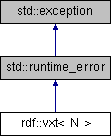 |
SASSY
0.0
Software Architecture Support System
|
 |
SASSY
0.0
Software Architecture Support System
|
An exception object with severity levels. More...
#include <rdfxx/except.h>

Public Member Functions | |
| vxt (Severity s) | |
| constructor More... | |
| vxt (Severity s, const std::string &f, int ln) | |
| constructor More... | |
| template<class T > | |
| vxt & | operator<< (T x) |
| Provide stream syntax for the exception object. | |
| Severity | severity () |
| get the severity of the exception | |
| virtual const char * | what () const throw () |
| get the message from the exception | |
Static Public Member Functions | |
| static const std::string & | sevToString (Severity s) |
| Convert a severity into a string. | |
Protected Attributes | |
| Severity | mSeverity |
| severity level of the exception | |
| std::string | buff |
| message built into this | |
| std::string | file |
| source file from which it was thrown | |
| int | line |
| line number in the source file | |
| int | ptr |
| insertion point for message text | |
An exception object with severity levels.
The vxt class is an exception object that includes severity levels and has stream syntax for creating messages.
Typical usage: throw vxt(VICI::Error) << "something went wrong: " << strerror(errno);
A macro version that automatically records the file name and line number is also defined. It would be used like:
throw VX(Warning) << "there is a problem";
constructor
| s | The severity of the problem. |
constructor
| s | the severity of the exception |
| f | the file name of the source file |
| ln | the line number of the source file |
 1.8.5
1.8.5